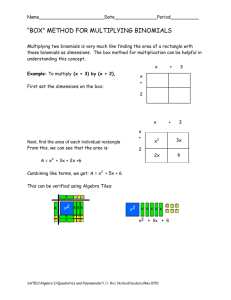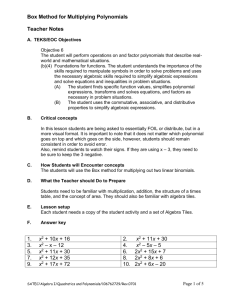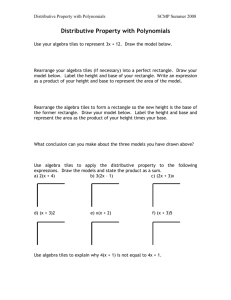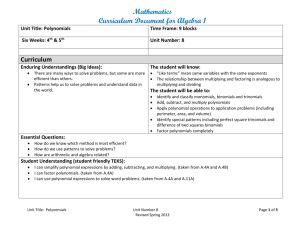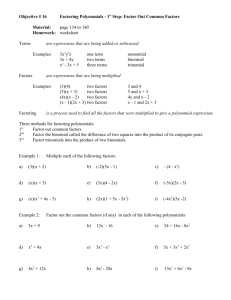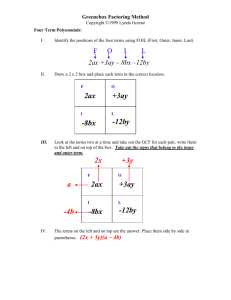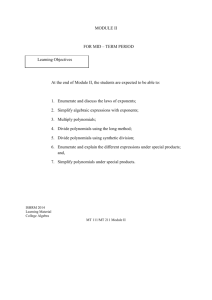Factoring Quadratics: Box Method Worksheet for Algebra I
advertisement
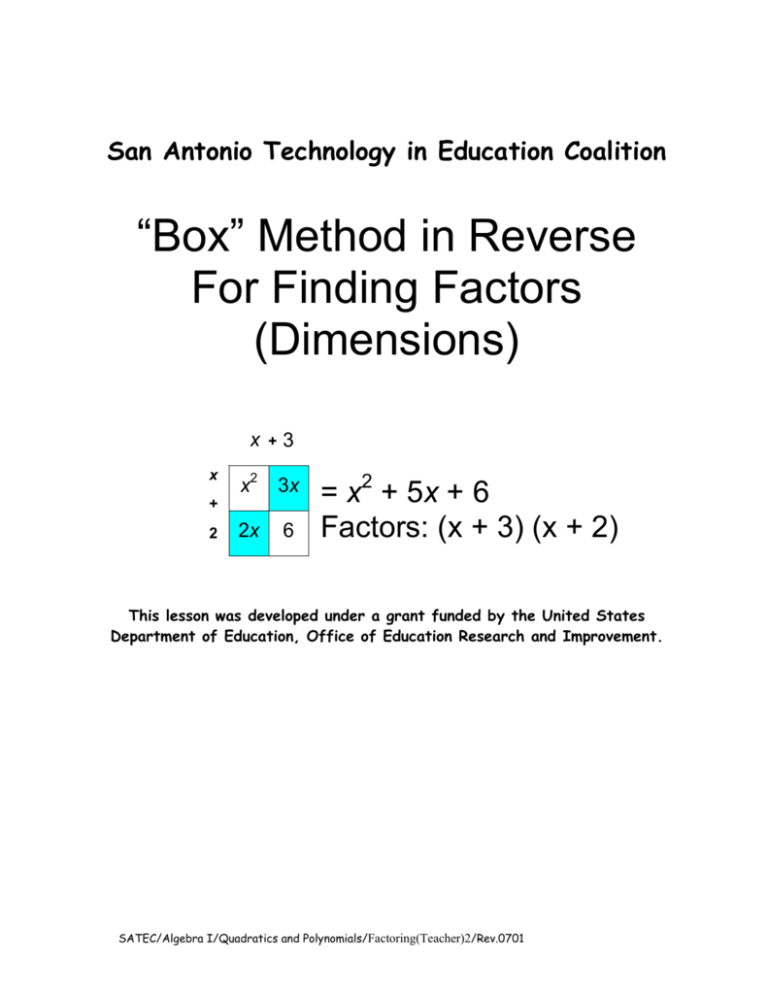
San Antonio Technology in Education Coalition “Box” Method in Reverse For Finding Factors (Dimensions) x x + 3 x2 3x 2x 6 + 2 = x2 + 5x + 6 Factors: (x + 3) (x + 2) This lesson was developed under a grant funded by the United States Department of Education, Office of Education Research and Improvement. SATEC/Algebra I/Quadratics and Polynomials/Factoring(Teacher)2/Rev.0701 Teacher Notes A. Student Objectives (TEKS) Objective 6 The student will perform operations on and factor polynomials that describe real-world and mathematical situations. (b)(4) Foundations for functions. The student understands the importance of the skills required to manipulate symbols in order to solve problems and uses the necessary algebraic skills required to simplify algebraic expressions and solve equations and inequalities in problem situations. (A) The student finds specific function values, simplifies polynomial expressions, transforms and solves equations, and factors as necessary in problem situations. (B) The student uses the commutative, associative, and distributive properties to simplify algebraic expressions. B. Critical concepts In this lesson students are being asked to essentially FOIL or distribute, but in a more visual format. It is important to note that it does not matter which polynomial goes on top and which goes on the side, however, students should remain consistent in order to avoid error. Also, remind students to watch their signs. If they are using x – 3, they need to be sure to keep the 3 negative. C. How Students will Encounter concepts The students will use the Box method for multiplying out two linear binomials. D. What the Teacher should Do to Prepare Students need to be familiar with multiplication, addition, the structure of a times table, and the concept of area. They should also be familiar with algebra tiles. E. Lesson setup Each student needs a copy of the student activity and a set of Algebra Tiles. F. Answer key 1. AREA (Product) 2x2 – 2x DIMENSIONS (Factors) (2x)(x – 1) 2. x2 + 5x + 4 (x + 1)(x + 4) 3. x2 + 3x – 4 (x + 4)(x – 1) 4. 2x2 + 7x + 3 (x + 3)(2x + 1) SATEC/Algebra I/Quadratics and Polynomials/Factoring(Teacher)2/Rev.0701 Page 2 of 5 AREA (Product) DIMENSIONS (Factors) 5. x2 + 2x – 3 (x – 1)(x + 3) 6. x2 – x – 12 (x + 3)(x – 4) 7. x2 + 2x – 8 (x + 4)(x – 2) 8. 2x2 + 5x + 3 (x + 1)(2x + 3) 9. 2x2 + 11x + 5 (2x + 1)(x + 5) 10. 2x2 + 7x + 5 (x + 1)(2x + 5) 11. 4x2 – 6x (2x)(x – 3) 12. 3x2 – 12x (3x)(x – 4) 13. x2 – x – 2 (x – 2)(x + 1) 14. x2 + 6x + 5 (x + 2)(x + 3) 15. x2 + 7x + 6 (x + 6)(x + 1) 16. x2 + 8x + 16 (x + 4)(x + 4) 17. x2 + 13x + 12 (x + 12)(x + 1) 18. x2 + 11x + 30 (x + 6)(x + 5) 19. x2 + 4x + 4 (x + 2)(x + 2) 20. x2 + 2x + 1 (x + 1)(x + 1) To check answers with the Algebra Tiles, student will use the dimensions they found and fill in the area to see if the appropriate area results. G. Suggested homework A similar worksheet would be ideal for students to practice for homework. I. Extensions Students can check solutions by entering the trinomial in the graphing calculator and sketching the graph. Then, have them enter the factor pair in the graphing calculator and sketch and compare the graph of the factor pair to the graph of the trinomial. If they match, the students found the correct factors. SATEC/Algebra I/Quadratics and Polynomials/Factoring(Teacher)2/Rev.0701 Page 3 of 5
